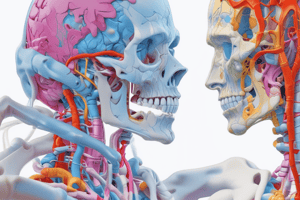Podcast
Questions and Answers
Why is water preferred over iodine-based contrast for contrast-enhanced MDCT in pancreatic imaging?
Why is water preferred over iodine-based contrast for contrast-enhanced MDCT in pancreatic imaging?
- Iodine-based contrast interferes with the detection of radio opaque stones in the common bile ducts.
- Iodine-based contrast is more effective at distending the stomach, duodenum, and jejunum.
- Iodine-based contrast enhances the visibility of gastric and duodenal wall lesions better than water.
- Iodine-based contrast interferes with volume-rendered reconstructions of the peri-pancreatic vessels. (correct)
Which anatomical region defines the inferior border of the scanned area during a contrast-enhanced MDCT for pancreatic imaging?
Which anatomical region defines the inferior border of the scanned area during a contrast-enhanced MDCT for pancreatic imaging?
- The stomach
- The common bile duct
- The diaphragm
- The transverse duodenum (correct)
What volume of water should patients typically drink before undergoing contrast-enhanced MDCT for pancreas imaging, and why?
What volume of water should patients typically drink before undergoing contrast-enhanced MDCT for pancreas imaging, and why?
- Approximately 250 mL, to improve contrast resolution.
- No water is needed, as the contrast agent provides sufficient distention.
- Approximately 500 mL, to reduce peristalsis.
- Approximately one liter, to distend the stomach, duodenum, and jejunum. (correct)
What is the primary reason for using water as a contrast agent in MDCT imaging of the pancreas, besides avoiding interference with peri-pancreatic vessels?
What is the primary reason for using water as a contrast agent in MDCT imaging of the pancreas, besides avoiding interference with peri-pancreatic vessels?
During contrast-enhanced MDCT, what is the significance of performing the scan within a single breath-hold?
During contrast-enhanced MDCT, what is the significance of performing the scan within a single breath-hold?
Why is it advantageous that water does not mask radio opaque stones in the common bile ducts during MDCT?
Why is it advantageous that water does not mask radio opaque stones in the common bile ducts during MDCT?
What range of the body should be covered during the scanning process?
What range of the body should be covered during the scanning process?
What benefit does water offer over barium-based contrast materials in the context of MDCT for pancreatic imaging?
What benefit does water offer over barium-based contrast materials in the context of MDCT for pancreatic imaging?
A patient is undergoing MDCT for pancreatic evaluation, and a small lesion is suspected in the duodenal wall. How might the use of water as a contrast agent aid in the diagnosis?
A patient is undergoing MDCT for pancreatic evaluation, and a small lesion is suspected in the duodenal wall. How might the use of water as a contrast agent aid in the diagnosis?
Why is a negative contrast medium like water favored over a positive contrast agent when examining the peri-pancreatic area with MDCT?
Why is a negative contrast medium like water favored over a positive contrast agent when examining the peri-pancreatic area with MDCT?
Flashcards
Water Consumption Before MDCT
Water Consumption Before MDCT
Drinking approximately one liter of water before contrast-enhanced MDCT to distend the stomach, duodenum, and jejunum for better visualization of the pancreas.
MDCT Scan Area
MDCT Scan Area
Extends from the diaphragm to below the transverse duodenum, performed in a single breath-hold to minimize motion artifacts.
Preferred Contrast Medium
Preferred Contrast Medium
Water is preferred over iodine or barium-based contrasts in MDCT imaging of the pancreas.
Benefit of Negative Contrast
Benefit of Negative Contrast
Signup and view all the flashcards
Advantage for Stone Detection
Advantage for Stone Detection
Signup and view all the flashcards
Evaluation of Gastric Walls
Evaluation of Gastric Walls
Signup and view all the flashcards
Study Notes
- Contrast-enhanced MDCT scans require patients to drink approximately one liter of water before the procedure.
- Water distends the stomach, duodenum, and jejunum, which facilitates the detection of pancreatic abnormalities.
- The scanned area spans from the diaphragm to below the transverse duodenum, all within a single breath-hold.
- Water is the preferred negative contrast medium over iodine or barium-based positive contrast materials.
- Water does not interfere with volume-rendered reconstructions of peripancreatic vessels.
- Water does not mask radio-opaque stones in the common bile ducts.
- Water supports the assessment of gastric and duodenal wall lesions.
Studying That Suits You
Use AI to generate personalized quizzes and flashcards to suit your learning preferences.




